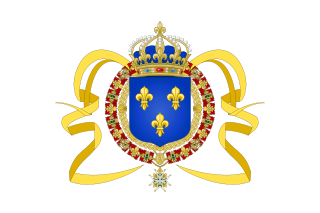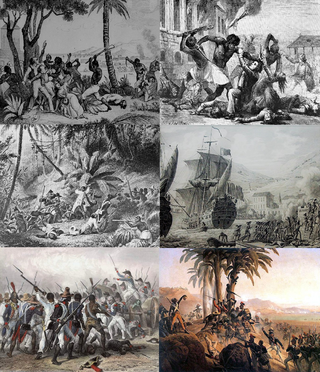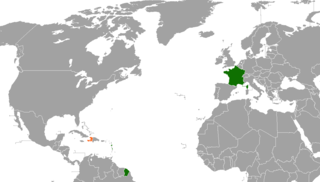Related Research Articles

François-Dominique Toussaint Louverture also known as Toussaint L'Ouverture or Toussaint Bréda, was a Haitian general and the most prominent leader of the Haitian Revolution. During his life, Louverture first fought and allied with Spanish forces against Saint-Domingue Royalists, then joined with Republican France, becoming Governor-General-for-life of Saint-Domingue, and lastly fought against Bonaparte's republican troops. As a revolutionary leader, Louverture displayed military and political acumen that helped transform the fledgling slave rebellion into a revolutionary movement. Along with Jean-Jacques Dessalines, Louverture is now known as one of the "Fathers of Haiti".

Jean-Jacques Dessalines was the first Haitian Emperor, leader of the Haitian Revolution, and the first ruler of an independent Haiti under the 1805 constitution. Initially regarded as governor-general, Dessalines was later named Emperor of Haiti as Jacques I (1804–1806) by generals of the Haitian Revolutionary army and ruled in that capacity until being assassinated in 1806. He spearheaded the resistance against French rule of Saint-Domingue, and eventually became the architect of the 1804 massacre of the remaining French residents of newly independent Haiti, including some supporters of the revolution. Alongside Toussaint Louverture, he has been referred to as one of the fathers of the nation of Haiti. Dessalines was directly responsible for the country, and, under his rule, Haiti became the first country in the Americas to permanently abolish slavery.

Saint-Domingue was a French colony in the western portion of the Caribbean island of Hispaniola, in the area of modern-day Haiti, from 1697 to 1804. The name derives from the Spanish main city on the island, Santo Domingo, which came to refer specifically to the Spanish-held Captaincy General of Santo Domingo, now the Dominican Republic. The borders between the two were fluid and changed over time until they were finally solidified in the Dominican War of Independence in 1844.

Divisional-General Charles Victoire Emmanuel Leclerc was a French Army officer who served during the French Revolutionary Wars. He was the husband of Pauline Bonaparte, the sister of Napoleon. In 1801, Leclerc was sent to Saint-Domingue, where invasion forces under his command captured and deported Haitian leader Toussaint Louverture to France as part of an unsuccessful attempt to reassert French control over Saint-Domingue and reinstate slavery in the colony. Leclerc died of yellow fever during the campaign.

Alexandre Sabès Pétion was the first president of the Republic of Haiti from 1807 until his death in 1818. One of Haiti's founding fathers, Pétion belonged to the revolutionary quartet that also includes Toussaint Louverture, Jean-Jacques Dessalines, and his later rival Henri Christophe. Regarded as an excellent artilleryman in his early adulthood, Pétion would distinguish himself as an esteemed military commander with experience leading both French and Haitian troops. The 1802 coalition formed by him and Dessalines against French forces led by Charles Leclerc would prove to be a watershed moment in the decade-long conflict, eventually culminating in the decisive Haitian victory at the Battle of Vertières in 1803.

The Haitian Revolution was a successful insurrection by self-liberated slaves against French colonial rule in Saint-Domingue, now the sovereign state of Haiti. The revolution was the only known slave uprising in human history that led to the founding of a state which was both free from slavery and ruled by non-whites and former captives.

Benoit Joseph André Rigaud was the leading mulatto military leader during the Haitian Revolution. Among his protégés were Alexandre Pétion and Jean-Pierre Boyer, both future presidents of Haïti.

The Battle of Vertières was the last major battle of the Haitian Revolution, and the final part of the Revolution under Jean Jacques Dessalines. It was fought on 18 November 1803 between the enslaved Haitian army and Napoleon's French expeditionary forces, who were committed to regaining control of the island.

The Haitian Revolution and the subsequent independence of Haiti as an independent state provoked mixed reactions in the United States. Among many white Americans, this led to uneasiness, instilling fears of racial instability on its own soil and possible problems with foreign relations and trade between the two countries. Among enslaved black Americans, it fueled hope that the principles of the recent American Revolution might be realized in their own liberation. While the Haitian Revolution was occurring during the presidencies of George Washington and John Adams, members of the Federalist Party including Alexander Hamilton supported Toussaint Louverture and his revolution. John Adams appointed Edward Stevens as US consul-general to Haiti to forge a closer relationship between the two nations and express US support for Louverture's government.

Jacques Maurepas was the commander of the town of Port-de-Paix in the northeast of St. Domingue which is now Haiti at the time when Napoleon sent a large army led by his brother-in-law general Charles Leclerc to overthrow Toussaint Louverture.
The War of Knives, also known as the War of the South, was a civil war from June 1799 to July 1800 between the Haitian revolutionary Toussaint Louverture, a black ex-slave who controlled the north of Saint-Domingue, and his adversary André Rigaud, a mixed-race free person of color who controlled the south. Louverture and Rigaud fought over de facto control of the French colony of Saint-Domingue during the war. Their conflict followed the withdrawal of British forces from the colony earlier during the Haitian Revolution. The war resulted in Toussaint taking control of the entirety of Saint-Domingue, and Rigaud fleeing into exile.
Lamour Desrances was a Haitian revolutionary leader. A former maroon, he was born in Africa and brought to Saint-Domingue as a slave. During the revolution, when local figures often gained power in control of small armed forces, Desrances became a local military leader in the mountains surrounding Port-au-Prince and Saint-Marc.

The Saint-Domingue expedition was a large French military invasion sent by Napoleon Bonaparte, then First Consul, under his brother-in-law Charles Victor Emmanuel Leclerc in an attempt to regain French control of the Caribbean colony of Saint-Domingue on the island of Hispaniola, and curtail the measures of independence and abolition of slaves taken by the former slave Toussaint Louverture. It departed in December 1801 and, after initial success, ended in a French defeat at the Battle of Vertières and the departure of French troops in December 1803. The defeat forever ended Napoleon's dreams of a French empire in the West.

France–Haiti relations are foreign relations between France and Haiti. Both nations are members of the Organisation internationale de la Francophonie, United Nations, and the World Trade Organization.
Jean Baptiste Brunet was a French general of division in the French Revolutionary Army. He was responsible for the arrest of Toussaint Louverture. He was promoted to command a light infantry demi-brigade at the Fleurus in 1794. He led the unit in François Joseph Lefebvre's division in the 1795, 1796 and 1799 campaigns. He was the son of French general Gaspard Jean-Baptiste Brunet who was guillotined in 1793.
Jean-Baptiste Sans-Souci was a leader of rebel slaves during the Haitian Revolution. He was assassinated by rival black rebel leader, Henri Christophe, in 1803, shortly before Haiti won its independence. Sans-Souci is notable as one of the most effective military leaders during the revolution, particularly against French forces led by Charles Leclerc in 1802 and 1803.

The Indigenous Army, also known as the Army of Saint-Domingue was the name bestowed to the coalition of anti-slavery men and women who fought in the Haitian Revolution in Saint-Domingue. Encompassing both black slaves, maroons, and affranchis, the rebels were not officially titled the Armée indigène until January 1803, under the leadership of then-general Jean-Jacques Dessalines. Predated by insurrectionists such as François Mackandal, Vincent Ogé and Dutty Boukman, Toussaint Louverture, succeeded by Dessalines, led, organized, and consolidated the rebellion. The now full-fledged fighting force utilized its manpower advantage and strategic capacity to overwhelm French troops, ensuring the Haitian Revolution was the most successful of its kind.
During the Haitian Revolution (1791–1804), Haitian women of all social positions participated in the revolt that successfully ousted French colonial power from the island. The 1791 revolt of enslaved individuals in Saint-Domingue was the most extensive and prosperous slave rebellion in recent times. In spite of their various important roles in the Haitian Revolution, women revolutionaries have rarely been included within historical and literary narratives of the slave revolts. However, in recent years extensive academic research has been dedicated to their part in the revolution.

Saint-Domingue Creoles or simply Creoles, were the people who lived in the French colony of Saint-Domingue prior to the Haitian Revolution.
Moyse Hyacinthe L'Ouverture was a military leader in Saint-Domingue during the Haitian Revolution. Originally allied with Toussaint L'Ouverture, Moyse grew disillusioned with the minimal labor reform and land distribution for black former slaves under the L'Ouverture administration and lead a rebellion against Toussaint in 1801. Though executed, the insurrection he directed highlighted the failure of the Haitian Revolution in creating real revolutionary labor change and ignited the movement that drove L’Ouverture from office.
References
- Philippe R. Girard, A History of Haiti: Rise and Demise of the Pearl of the Caribbean (New York: Palgrave, 2010).
- Philippe R. Girard, "Trading Races: Joseph and Marie Bunel, a Diplomat and a Merchant in Revolutionary Saint-Domingue and Philadelphia", Journal of the Early Republic 30:3 (Fall 2010), pp. 351–76.
- Philippe R. Girard, “Black Talleyrand: Toussaint Louverture’s Secret Diplomacy with England and the United States,” William and Mary Quarterly 66:1 (Jan. 2009), 87–124.
- Gordon S. Brown, Toussaint's Clause: The Founding Fathers and the Haitian Revolution (University Press of Mississippi, 2005).
Notes
- ↑ Girard, "Trading Races."
- ↑ Alexander DeConde, The Quasi-War (New York: Scribner's, 1966), pp. 135-36.
- ↑ Brown, "Toussaint's Clause," p. 137.
- ↑ Thomas Hart Benton, Abridgment of the Debates of Congress, from 1789 to 1856 Vol. 2 (New York: D. Appleton and Company, 1857), p. 339.
- ↑ Madison Smartt Bell, Toussaint Louverture (Vintage Books, 2008), pp. 210-11.
- ↑ Girard, Philippe (2009). "Rebelleswith a Cause: Women in the Haitian War of Independence, 1802-04". Gender & History. 21: 60–85. doi:10.1111/j.1468-0424.2009.01535.x.
- ↑ Girard, "Trading Races."